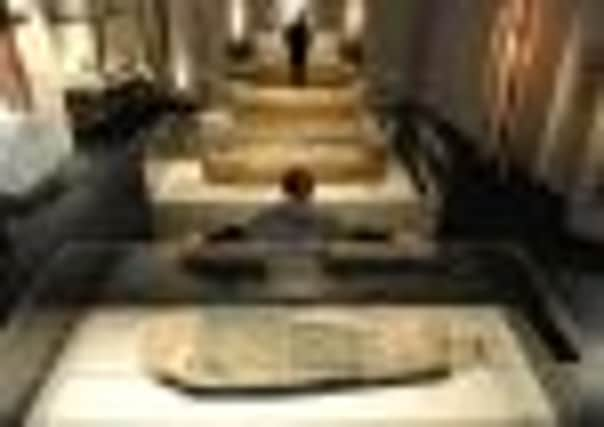Magnificent city attractions display talents to the nation


• The National Museum of Scotland unveiled its most significant redevelopment in over a century last summer. The refurbishment of the old and much-loved museum in Chambers Street has restored this landmark building to the Victorian grandeur of its early years, and also created 16 new galleries that showcase 8000 objects, most of them on public display for the first time. Since opening, it has welcomed 1.8 million visitors.
The nation’s central role in the British Empire is well known by scholars, but many Scots and visitors to Scotland are unaware of the extent to which this relatively small nation “punched well above its weight” in the world of empire. The new Discoveries gallery can change that, because so many of the objects on show are the fruits of the empire, brought home by Scottish adventurers, merchants, soldiers, missionaries, administrators, physicians and engineers.
Advertisement
Hide AdAdvertisement
Hide AdParts of that story can be uncomfortable. The reputation of Scots as the hard men of empire was no myth. Many of the battle honours displayed proudly at the Royal Edinburgh Military Tattoo were won in the vast territorial expansion of empire in the 18th and 19th centuries.


Yet the Scottish impact abroad was far from being only brutal. Today’s museum grew out of the Society of Antiquaries of Scotland, a product of the Scottish Enlightenment – an unprecedented outpouring of advanced thinking in subjects ranging from philosophy to geology, history to medicine, jurisprudence to natural science, which touched every aspect of peoples’ lives.
Objects on display include Sir David Baird’s jewel encrusted sword, awarded to him following his campaign against Tipu Sultan in the 18th century; a portrait of Alexander Dalrymple, who designed the first Admiralty Charts; and an 18th century carved ivory lantern presented to William Fullerton Elphinstone during a career of over 70 years’ service with the British East India Company.
The new Museum is a superb destination for all who want to appreciate the multifaceted story of Scotland. The overwhelming enthusiasm shown by visitors is well deserved, and the Museum would be a worthy
winner of The Art Fund Prize.
Advertisement
Hide AdAdvertisement
Hide AdProfessor Tom Devine, Senior Research Professor in History and Director of the Scottish Centre of Diaspora Studies, University of Edinburgh
• THERE is a photograph on exhibition in the Scottish National Portrait Gallery (SNPG) which (today at any rate) is my favourite piece. It captures a moment in a Christmas party at Port Glasgow in 2006. The photographer is in the thick of it, but is invisible to the party-goers. There must be more than a hundred people in the picture, and he captures most of their faces. It’s a moment of happy abandon. The people are having the time of their lives, comfortable, in this instant at least, in their own skins, and delighted to be in each other’s company.
Every time you look at it you see something new. And then you realise you see people you know. You see your own country. You see yourself.
That is the wonder of the new portrait gallery. It is itself a portrait – a portrait of the Scotland we all live in and contribute to.
Advertisement
Hide AdAdvertisement
Hide AdI’ve known the SNPG since I first came to Edinburgh as a student in the 1970s. I loved individual pieces in it. But now it has the coherence of a single integrated – but rich and diverse – story. The story of us.
The building is itself an exhibit to enjoy and celebrate. It was the first purpose-built portrait gallery in the world, designed by the most celebrated Scottish Architect of his day, Sir Robert Rowand Anderson.
He was famous for his use of vivid colour. For decades that colour was lost beneath a pall of Edinburgh reek. But it’s back. The building has been brought brilliantly into the twenty-first century without betraying the character of Anderson’s original.
The Gallery now takes you through Scotland’s story and the individuals who shaped it. You move from a society that venerated clerics and kings and noblemen, through the eighteenth century enlightenment, and you watch portraiture change in what it sought to celebrate. You watch as Scotland democratises. You watch the common man and woman emerge from the shadows and take centre stage and shape the character of the country.
Advertisement
Hide AdAdvertisement
Hide AdSo go to the new Portrait Gallery. It is connected to the crashing, dynamic turmoil of the streets around it, in a way that the old one, full of wonderful art though it was, was not.
You will see a portrait of your own country. It is about where we are going as well as where we have come from. You will see portraits of people you know. You will see yourself, and the centuries of individual human endeavour that shaped you. For that’s what this Gallery is about. It’s about us all.
Allan Little is a Special Correspondent with the BBC
IN THE FRAME
The Art Fund Prize recognises originality and excellence in museums and galleries in the UK. A single award of £100,000 is presented to the attraction which does most to increase public appreciation and enjoyment of what it has to offer. The National Museum of Scotland and the Scottish National Portrait Gallery are competing against a range of institutions, including Glasgow’s Riverside Museum of transport.